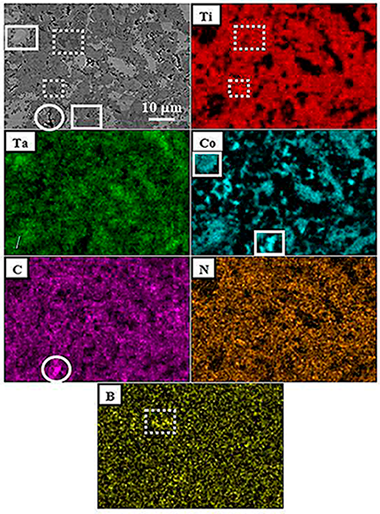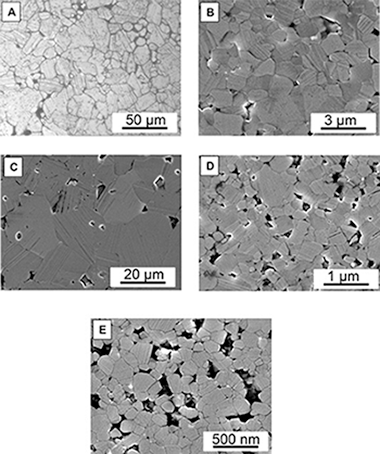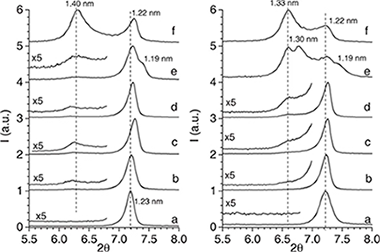Artículos SCI
2019
2019
Nanotecnología en Superficies y Plasma
Large gap atmospheric pressure barrier discharges using ferroelectric materials
Navascues, P.; Gonzalez-Elipe, A. R.; Cotrino, J.; Gomez-Ramirez, A.Plasma Sources Sciences & Tecnology, 28 (2019) 075002
Show abstract ▽
This work reports a phenomenological comparative study of atmospheric pressure barrier plasmas using ferroelectric (ferroelectric barrier discharge (FBD)) and dielectric (dielectric barrier discharge (DBD)) plates to moderate the discharge. For FBD operation and large inter-electrode distances, experiments with helium carried out in a parallel plate reactor as a function of applied voltage have shown an enhancement of one order of magnitude in the charge transferred through the circuit. In a similar way to DBDs, FBDs rendered a laterally localized arrangement of discrete columnar discharges with a pattern distribution and an overall current intensity that depended on operation conditions. However, unlike the regular columnar pattern found for DBD operation, discharge columns in the FBD mode appear randomly and inhomogeneously distributed on the ferroelectric surface. This geometrical behavior of FBD plasma columns, as well as the singular variation of current with applied voltage and the particular shape characteristics of the current discharge curves have been accounted for by the high capacity of ferroelectric surfaces to randomly accumulate charge and to promote the emission of secondary electrons in the presence of a plasma.
Julio, 2019 | DOI: 10.1088/1361-6595/ab28ce
Reactividad de Sólidos
Effects of Boron Addition on the Microstructure and Mechanical Properties of (Ti,Ta)(C,N)-Co Based Cermets
Chicardi, E; Martinez, FJGMetals, 9 (2019) art. 787
Show abstract ▽

In this work, a titanium-tantalum carbonitride based cermet, with cobalt as the binder phase and boron as a sintering additive, was developed by a mechanically induced self-sustaining reaction process using two different methodologies. The boron additive was added to prevent the formation of brittle intermetallic compounds generally formed during the liquid phase sintering step due to the excessive ceramic dissolution into the molten binder phase. A systematic study was carried out to understand the effects of boron addition on the nature of the phases, microstructure, and mechanical properties of cermets. With the boron addition, the formation of two different boride solid solutions, i. e., (Ti, Ta)B-2 and (Ti, Ta)(3)B-4, was observed. Moreover, the nature of the binder was also modified, from the (Ti, Ta)Co-2 brittle intermetallic compound (for cermets without boron addition) to ductile and tough (Ti, Ta)Co-3 and alpha-Co phases (for cermets with boron addition). These modifications caused, as a general trend, the increase of hardness and toughness in cermets.
Julio, 2019 | DOI: 10.3390/met9070787
Propiedades mecánicas, modelización y caracterización de cerámicos avanzados
Does grain size have an influence on intrinsic mechanical properties and conduction mechanism of near fully-dense boron carbide ceramics?
Moshtaghioun, BM; Laguna-Bercero, MA; Gomez-Garcia, D; Pena, JIJournal of Alloys and Compounds, 795 (2019) 408-415
Show abstract ▽

This work is concentrated on getting a reply to the following question: how does the grain size of boron carbide specimens influence on their mechanical and electrical response? It is a common issue that both essential properties are usually affected by the grain boundaries. To this purpose, a set of near fully-dense boron carbide specimens were prepared by spark plasma sintering. In order to reduce residual porosity and grain-size effects, nanoindentation tests at room temperature were conducted. DC conductivity was measured through four-point test technique from room temperature up to 800 °C. The results show that hardness can reach values as high as ∼60 GPa and plasticity onset takes place at around 23 GPa by dislocation nucleation. Regarding the conductivity, it is found that grain boundaries can block the mobility of bipolarons in an effective way. A simple additive law is provided to account for the resistivity of boron carbide polycrystals.
Julio, 2019 | DOI: 10.1016/j.jallcom.2019.05.037
Materiales de Diseño para la Energía y Medioambiente
Bionanocomposites based on chitosan intercalation in designed swelling high-charged micas
Alba, MD; Cota, A; Osuna, FJ; Pavon, E; Perdigon, AC; Raffin, FScientific Reports, 9 (2019) art. 10265
Show abstract ▽

Bionanocomposites based on layered inorganic components, as clays, and polymers of biological origin, as chitosan, have a major impact in medical and environmental fields, being economical and environmentally friendly materials. Na-Mn micas (n = 2 and 4) with controlled surface charge, high cation exchange capacity and swelling behaviour, are attractive inorganic composite components that exhibit improved adsorption properties compared to other inorganic solids which makes them potentially useful for bionanocomposites. The goal of this research was to explore the potential use of those synthetic brittle micas to form eco-friendly bionanocomposites with chitosan biopolymer. Hence, chitosan-mica bionanocomposites were prepared by ion-exchange reaction between chitosan solution and synthetic high charge mica. X-ray diffraction, Fourier transform infrared spectroscopy, thermal analysis, MAS-NMR spectroscopy and zeta-potential have been employed for bionanocomposites characterization. The results showed that the adsorption of chitosan is effective, although a chitosan portion remains in the outer surface being hydrogen-bonded to the tetrahedral sheet of the silicate.
Julio, 2019 | DOI: 10.1038/s41598-019-46495-z
Nanotecnología en Superficies y Plasma
On‐Surface Synthesis and Characterization of Acene‐Based Nanoribbons Incorporating Four‐Membered Rings
Sanchez-Sanchez, C; Dienel, T; Nicolai, A; Kharche, N; Liang, LB; Daniels, C; Meunier, V; Liu, JZ; Feng, XL; Mullen, K; Sanchez-Valencia, JR; Groning, O; Ruffieux, P; Fasel, RChemistry-A European Journal
Show abstract ▽

A bottom up method for the synthesis of unique tetracene-based nanoribbons, which incorporate cyclobutadiene moieties as linkers between the acene segments, is reported. These structures were achieved through the formal [2+2] cycloaddition reaction of ortho-functionalized tetracene precursor monomers. The formation mechanism and the electronic and magnetic properties of these nanoribbons were comprehensively studied by means of a multitechnique approach. Ultra-high vacuum scanning tunneling microscopy showed the occurrence of metal-coordinated nanostructures at room temperature and their evolution into nanoribbons through formal [2+2] cycloaddition at 475 K. Frequency-shift non-contact atomic force microscopy images clearly proved the presence of bridging cyclobutadiene moieties upon covalent coupling of activated tetracene molecules. Insight into the electronic and vibrational properties of the so-formed ribbons was obtained by scanning tunneling microscopy, Raman spectroscopy, and theoretical calculations. Magnetic properties were addressed from a computational point of view, allowing us to propose promising candidates to magnetic acene-based ribbons incorporating four-membered rings. The reported findings will increase the understanding and availability of new graphene-based nanoribbons with high potential in future spintronics.
Julio, 2019 | DOI: 10.1002/chem.201901410
- ‹ anterior
- 131 of 420
- siguiente ›














